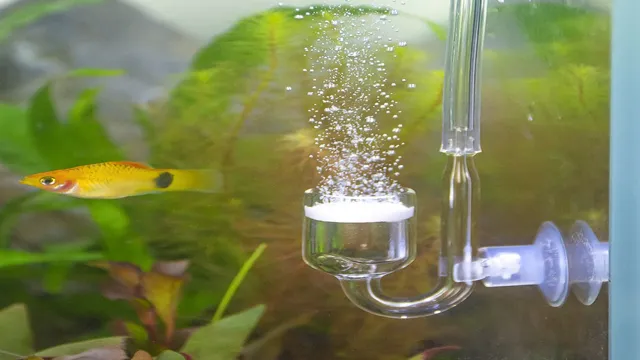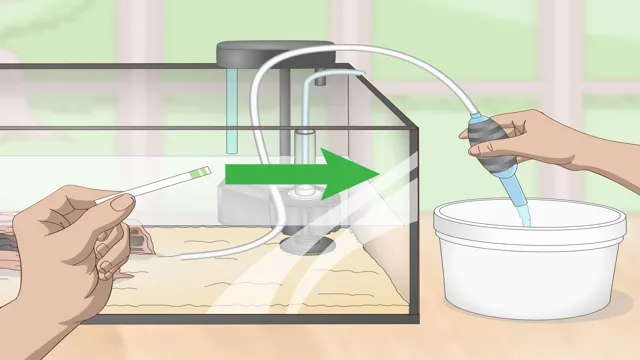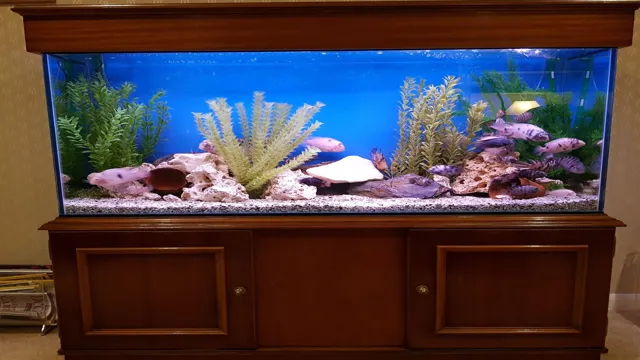Have you ever considered owning an aquarium without a filter? It may seem strange, but it’s actually a growing trend among aquarium enthusiasts. Aquariums without filters create a more natural and sustainable environment for aquatic life, but they also require a different approach to maintenance. In this beginner’s guide, we’ll touch on the benefits and challenges of owning an aquarium without a filter, and provide tips on how to maintain a healthy and thriving ecosystem.
So, if you love aquariums and want to try something new, keep reading to learn more about this fascinating topic!
The Basics of Aquarium Filtration
Having an aquarium without a filter may seem like a daunting task, but it can actually be done with some careful planning and attention. The key is to maintain a healthy and balanced ecosystem within the aquarium that promotes the growth of beneficial bacteria. This can be achieved through regular water changes, the addition of live plants, and the use of a substrate that promotes bacterial growth.
Another important aspect is ensuring that the aquarium isn’t overcrowded, as this can lead to an increase in waste and an unbalanced system. While it may require a bit more effort and attention, a filterless aquarium can be a beautiful and rewarding addition to your home or office.
Why Filters Are Important
Filters are an essential component in maintaining the water quality of your aquarium. They work by removing harmful substances such as fish waste and uneaten food, which can lead to poor water conditions that quickly become hazardous to your aquatic pets. By employing a filter, not only do you ensure a healthy living environment for your fish, but you also help to keep the water clear and free of algae, enhancing their overall appearance.
Filters come in a variety of types and sizes, and choosing the right one for your aquarium will depend on a few factors such as the size of your tank, the number of fish you have, and the type of fish and plants you are caring for. So don’t skimp on filtration – it’s a critical cornerstone in the healthy maintenance of your aquarium inhabitants.

How Filters Work
Aquarium filtration is essential for maintaining a healthy aquatic environment for your fish and other inhabitants. Filters work by removing physical and biological waste from the water, keeping the environment clean and clear. The basic principles of filtration involve three stages of cleaning: mechanical, chemical, and biological.
In the mechanical stage, coarse materials filter out large pieces of debris and waste, such as uneaten food and plant matter. In the chemical stage, activated carbon adsorbs impurities and toxins from the water, leaving it crystal clear. Finally, during the biological stage, beneficial bacteria break down harmful substances into less harmful compounds, converting fish waste into less toxic ammonia.
Choosing the right filter for your aquarium is important, as different types offer varying degrees of filtration. Hang-on-back filters are great for smaller aquariums, while canister filters are the best choice for larger tanks. Whichever type you choose, keeping your filter clean and well-maintained is crucial for its effectiveness.
Regularly cleaning and replacing filter media can ensure your filter continues to work properly and keeps your aquarium healthy for years to come. In summary, a properly functioning aquarium filter is key to maintaining a healthy and thriving aquatic environment. Understanding the different types of filtration and how they work is important for choosing the right filter for your tank’s needs.
With regular maintenance and care, your filter can keep your aquarium clean and clear for years to come.
Alternatives to Filters for Small Aquariums
If you’re looking for ways on how to make an aquarium without filter, there are several alternatives to consider. One option is to maintain a low number of fish and feed them sparingly. This can help minimize the amount of waste produced, which reduces the need for a filter.
Another option is to use live plants in the aquarium. Plants can help absorb excess nutrients and provide oxygen to the water. It’s also important to do regular water changes to remove any build-up of toxins and keep the water clean.
Finally, you can consider using a sponge filter or an air pump and airstone to provide some filtration and oxygenation without the need for a traditional filter. With these alternatives, it’s possible to maintain a healthy and thriving aquarium without relying on a filter.
Planted Aquariums
Planted Aquariums When it comes to small planted aquariums, some fish enthusiasts prefer to skip the use of filters altogether, opting instead for alternative methods to maintain water cleanliness. One such method is the use of live plants. Not only do these plants serve as a natural filtration system by absorbing nitrates and other harmful substances, but they also provide a natural and visually pleasing aesthetic. (See Also: How to Assemble Jepo AP115F Aquarium Liquid Filter: Step-by-Step Guide)
Another alternative method is the use of small sponge filters, which are both cost-effective and low-maintenance. These filters work by pulling water through a sponge, which collects debris and bacteria, effectively cleaning the water. Overall, using plants or sponge filters in small planted aquariums can be a great alternative to traditional filters, providing both a natural and efficient way of maintaining water cleanliness.
Simple Water Changes
For small aquarium owners who don’t like to use filters, water changes are a simple and effective way to maintain a healthy environment for your fish. However, the process can be a little daunting if you’ve never done it before. First, make sure you have a siphon or vacuum designed for aquariums.
This tool will allow you to easily remove debris and waste from the bottom of the tank without disturbing the gravel. Once you have your siphon, use it to remove around 25% of the water from your tank and replace it with fresh, dechlorinated water. It’s important to not change all the water at once, as this can shock your fish.
Additionally, if you have live plants, make sure to remove any debris that has accumulated in them. Finally, be sure to clean any decorations or rocks in the tank to remove algae or other buildup. By regularly changing a portion of the water in your tank, you can help keep your fish happy and healthy.
Mechanical Filtration with Sponges
Mechanical filtration with sponges is a great alternative to traditional filters for small aquariums. Sponges are an excellent option for those who want a low-maintenance system that is still effective at keeping the water clean and clear. The mechanical filtration works by trapping debris and waste particles in the sponge, which can then be easily removed and cleaned.
This process not only keeps the water clean, but it also prevents the build-up of harmful substances that can harm both the aquatic inhabitants and the underwater environment. In addition to being effective, sponge filters are also affordable and easy to install. They generally take up less space than traditional filters, which makes them perfect for smaller tanks.
They also have a high level of durability and can last for years if properly maintained. So, if you are looking for an inexpensive and low-maintenance option for your small aquarium, mechanical filtration with sponges may be the perfect choice for you. Overall, mechanical filtration with sponges is a fantastic alternative to traditional filters for small aquariums.
With their low-maintenance requirements, effectiveness, affordability, and ease of installation, sponge filters are a great option for those wanting a clean and healthy environment for their aquatic pets. So, why not give it a try and see the benefits for yourself?
Creating a Low-Maintenance Aquarium
Aquariums are a great way to add life and vitality to any room, but they can also require a lot of maintenance if you want to keep the water clear and healthy for your fish. However, it is possible to create a low-maintenance aquarium without a filter. First, choose hardy fish species that can tolerate variations in water temperature and quality.
Secondly, use a substrate that promotes the growth of beneficial bacteria, which will help to break down waste and keep the water clean. Thirdly, add live plants, which will absorb excess nutrients and help to oxygenate the water. Finally, perform regular water changes to remove any debris that may have accumulated.
While a filter can make things easier, it is possible to create an attractive and healthy aquarium without one with some careful consideration and attention to detail.
Choosing Low-Maintenance Fish and Plants
When it comes to creating a low-maintenance aquarium, choosing the right fish and plants is key. Firstly, it’s important to opt for hardy fish species like guppies, tetras, and danios that can tolerate fluctuations in water chemistry and temperature. They also require minimal maintenance, making them ideal for beginners or those with busy schedules.
Similarly, selecting low-maintenance plants like anubias, java fern, or mosses is essential. These plants require low to moderate light, don’t need fertilizers, and grow slowly, minimizing the need for regular pruning. Choosing the right substrate and filtration system can also go a long way in reducing maintenance tasks.
Overall, taking the time to select low-maintenance fish and plants will help create an aquarium that’s both beautiful and easy to care for. (See Also: How to Clean Biohome Aquariums: Tips and Tricks for Sparkling Clean Aquatic Environments)
Maintaining Water Quality without Filters
Maintaining water quality without filters can seem like a daunting task, but it is possible to create a low-maintenance aquarium if you follow some simple steps. First and foremost, it’s important to choose the right type and number of fish for your tank, as overcrowding can lead to a buildup of waste and other pollutants in the water. Additionally, regularly performing partial water changes and keeping the tank clean can significantly reduce the need for a filter.
Plants can also be a great addition to your aquarium, as they help to naturally filter out harmful chemicals and waste from the water. Finally, incorporating beneficial bacteria through the use of a substrate or additives can help to break down organic matter and keep your water clean and healthy. By following these tips and maintaining good water quality, you can enjoy a beautiful and low-maintenance aquarium without the need for filters.
Tips for Success without Filters
If you’re looking to make an aquarium without a filter, there are a few things you can do to ensure its success. Firstly, make sure the tank is appropriately sized for your fish with plenty of room to swim and hide. You’ll want to keep the water clean by regularly changing it and using live plants to help absorb any excess waste.
Another important factor is feeding your fish the appropriate amount of food and removing any excess uneaten food to prevent buildup and pollution. Consider using a sponge filter, which is a gentle and effective way to keep the water clean without creating too much water flow. Lastly, make sure to monitor the water quality regularly using a test kit to ensure your fish remain healthy.
By following these tips, you can successfully maintain a beautiful and healthy aquarium without the use of a filter.
Monitor Water Parameters Regularly
Keeping your aquarium healthy and your fish happy requires some effort, but it doesn’t necessarily mean you have to rely exclusively on filters. One of the essential things for maintaining optimal water quality and promoting the well-being of your aquatic pets is regular water parameter monitoring. This way, you’ll be able to detect any unwanted changes in the pH levels, ammonia, nitrite, and nitrate concentrations, and act accordingly before the fish gets sick or dies.
You can use simple and affordable test kits, which come with precise instructions and provide fast and accurate results. Monitoring water parameters can also help you adjust the feeding and water changing frequency, determine whether the filtration system is working correctly and make any necessary changes in the aquarium setup. Remember, regular water testing is critical, and you should do it at least once a week to ensure your aquarium stays healthy and thriving.
Don’t Overfeed Your Fish
Overfeeding your fish can cause them harm. While it’s tempting to give your fish lots of food, this can have negative consequences. Overfeeding can result in too much waste in your aquarium, which will quickly lead to poor water quality.
This waste can clog the filter, making it less effective, and can also cause an algae bloom. To avoid overfeeding, use a feeding schedule and only feed your fish what they can eat in a few minutes. If there is any leftover food, remove it from the tank.
You can also consider feeding your fish a variety of food, such as pellets, flakes, and freeze-dried options. By not overfeeding your fish, you will help to keep your aquarium clean and healthy.
Vacuum the Gravel Regularly
Vacuuming the gravel regularly is key to maintaining a successful aquarium without filters. Gravel not only adds aesthetic value to your aquarium, but it also acts as a filter for waste and bacteria. Therefore, it is essential to keep the gravel clean in order to prevent any buildup of harmful substances.
You can use a siphon vacuum to easily remove debris and waste from the gravel bed. Regular vacuuming will also help prevent the buildup of harmful nitrates and phosphates, which can negatively impact the health of your fish and plants. Plus, it also keeps the water crystal clear, making your aquarium look its best.
So, if you want to be successful without filters, vacuuming the gravel should be at the top of your to-do list. (See Also: How to Help Prevent Algae in Fish Aquarium: Tips and Tricks)
Introduce Beneficial Bacteria
Introducing Beneficial Bacteria for Tank Success Without Filters Did you know that beneficial bacteria play a crucial role in creating a healthy environment for your fish tank? Even without the use of filters, you can promote a thriving ecosystem with the help of these microscopic organisms. Beneficial bacteria break down waste and convert harmful toxins into less harmful substances, ensuring a healthy living environment for your aquatic creatures. One way to introduce these helpful bacteria is by using live plants.
Plants release oxygen into the water, creating a hospitable environment for beneficial bacteria to grow and thrive. Another method is by adding beneficial bacterial supplements to your tank. These supplements contain live bacteria cultures and help establish the necessary bacterial colonies needed to maintain water quality.
By implementing these simple techniques, you can provide your fish with a sustainable and healthy home without relying on filters.
Conclusion
Creating an aquarium without a filter is like building a sandcastle without a bucket – it can be done, but it takes time, patience, and a lot of effort. It involves careful planning, regular maintenance, and a deep understanding of the delicate ecosystem you’re trying to create. So, if you’re up for the challenge, roll up your sleeves, get your hands wet, and let the magic happen!”
FAQs
What are the alternatives to using a filter in an aquarium?
Some alternatives to using a filter include regular water changes, adding live plants, and using a sponge filter.
Can I successfully maintain an aquarium without a filter?
While it is possible to maintain an aquarium without a filter, it requires diligent care and attention to water quality and cleanliness.
What are some common challenges of keeping an aquarium without a filter?
Common challenges of keeping an aquarium without a filter include managing water quality, preventing algae growth, and ensuring adequate oxygen levels.
What are some benefits of maintaining an aquarium without a filter?
Benefits of maintaining an aquarium without a filter may include a more natural and organic environment for your aquatic pets, reduced noise and energy use, and lower equipment costs.
Can I use a DIY filter instead of purchasing one for my aquarium?
Yes, you can make your own filter using materials such as sponge, gravel, and activated carbon. There are also many online tutorials available for making DIY filters.
How often should I perform water changes in an aquarium without a filter?
It is recommended to perform water changes of at least 25% every week in an aquarium without a filter to maintain water quality and cleanliness.
What types of fish or aquatic pets are best suited for an aquarium without a filter?
Fish and aquatic pets that are hardy and able to tolerate changes in water quality are best suited for an aquarium without a filter. Some examples include guppies, bettas, and goldfish.







